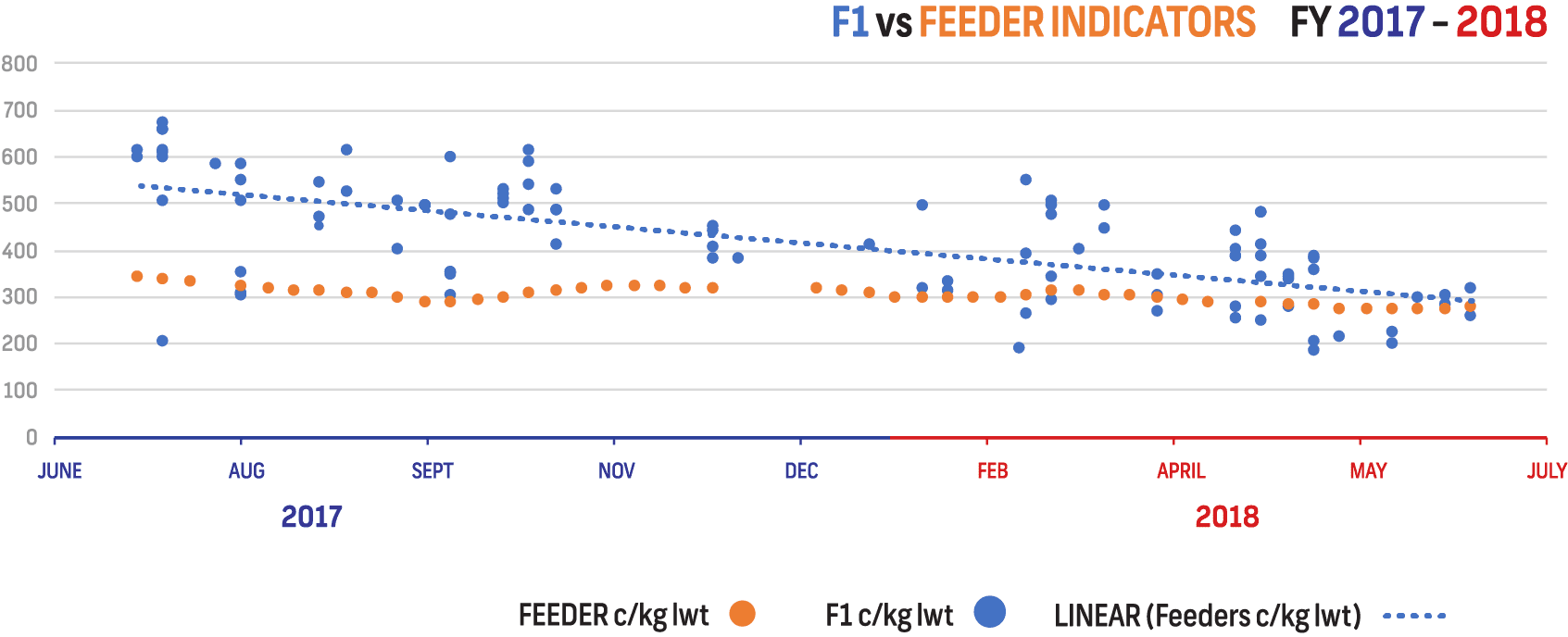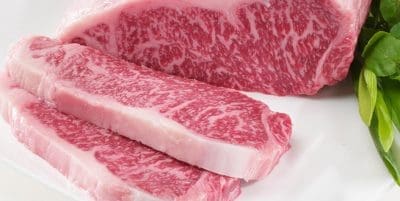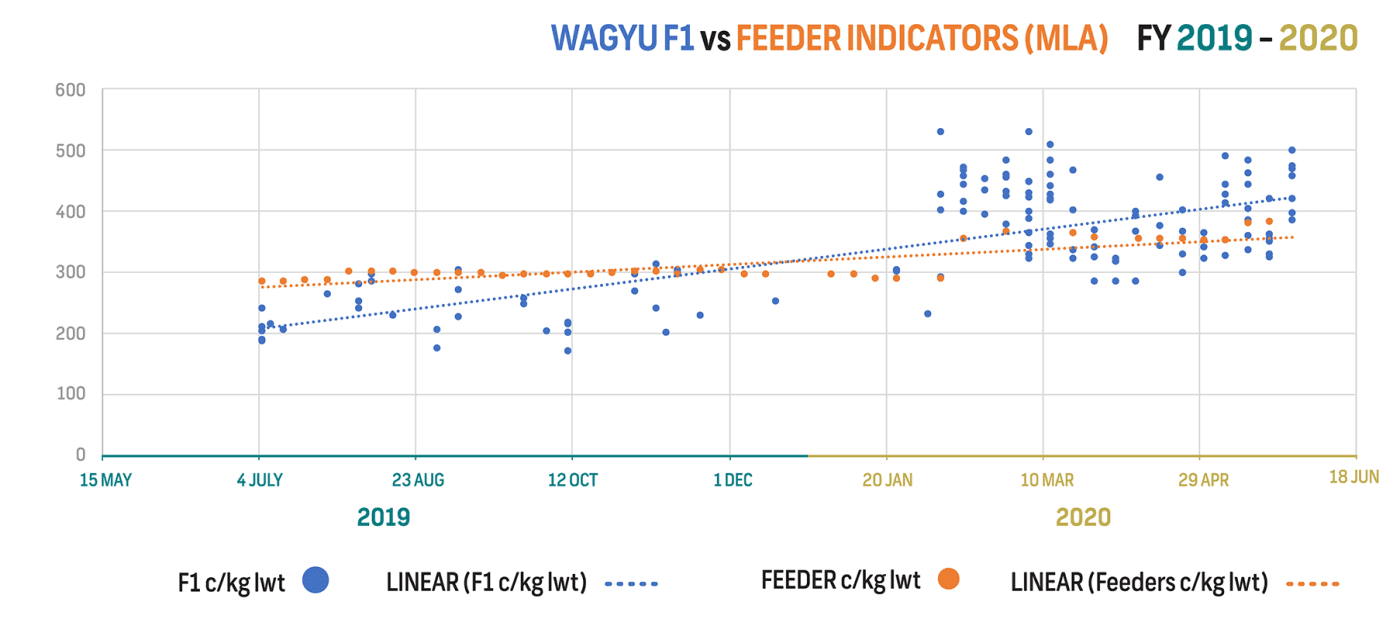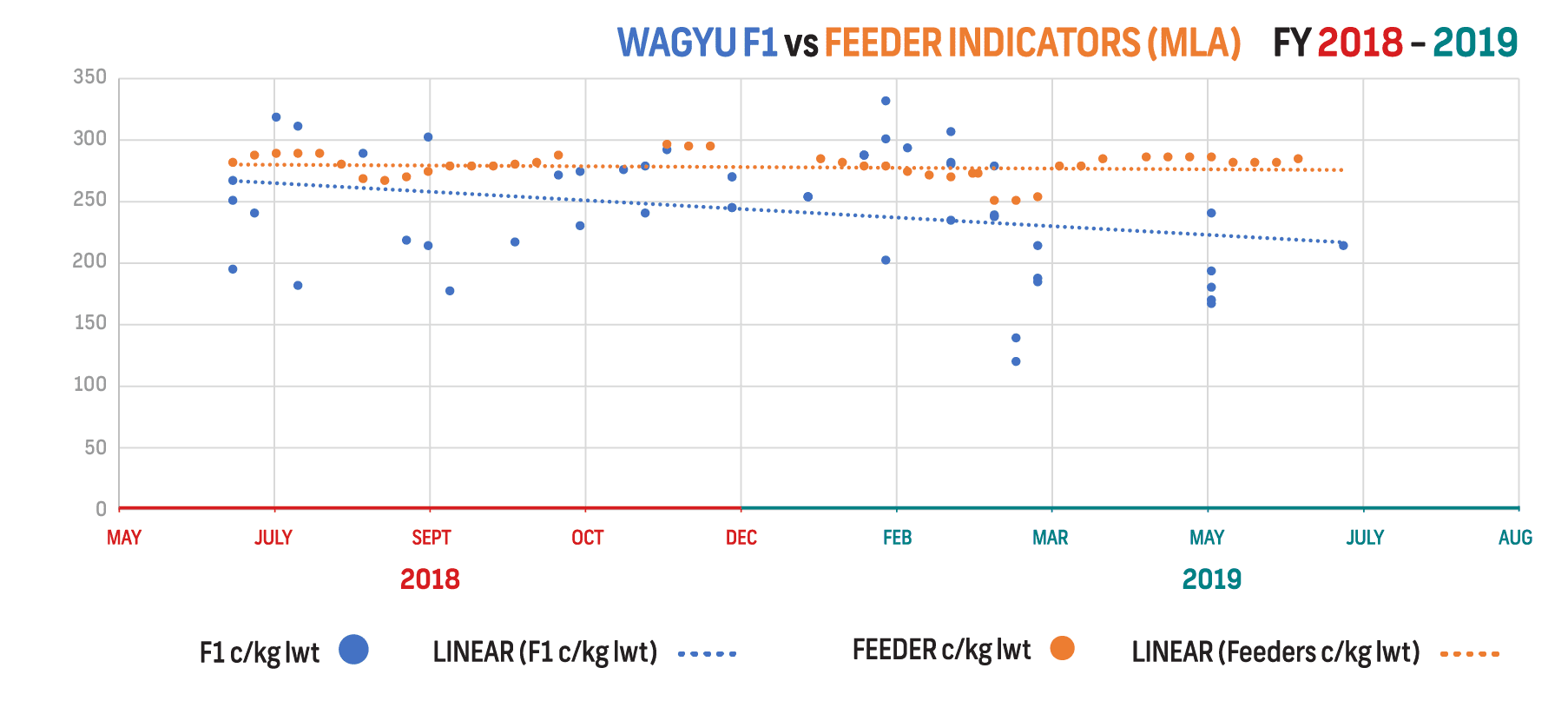AFTER a spectacular collapse in value over the previous two years due to oversupply, Wagyu F1 feeder cattle prices are in recovery mode, and indeed appear to have again established a distinct premium over Angus equivalents, for the right cattle.
In broad terms, the price quotes from large F1 supply chains set out below are now probably 50c/kg (on average) above equivalent straightbred Angus feeders. That’s the first time that has happened since late 2017.
Here’s a brief history of Wagyu F1 prices, and what has driven them:
- In 2016, Wagyu feeder prices started to climb dramatically, as rapidly expanding international demand met moderate supply. Headline-grabbing price results prompted a wave of opportunistic F1 breeding – not only within Angus breeding herds, but a spectrum of other breed types as well.
- A serious oversupply period emerged in 2018 and 2019 as those progeny worked their way through the system. While well-bred F1s carrying the right sire and dam side genetics continued to find buyer support, large numbers of less desirable Wagyu F1 types struggled to find a home, and were heavily discounted – often carrying no Wagyu premium at all.
- The past six months, however has produced a solid rally in F1 Wagyu feeder prices, restoring some of the ‘gloss’ the category previously enjoyed.
Those patterns are clearly evident in these three graphs, produced by the Australian Wagyu Association, covering the past three financial years’ worth of Wagyu F1 trading on AuctionsPlus.
Note from the outset that trading in Wagyu F1s via AuctionsPlus, or physical saleyards for that matter, is extremely thin, and cannot be used as any reliable barometer of market price. The overwhelming majority of sales are negotiated privately, in the paddock. But the graphs do capture the broader price trend that’s been seen across the industry since 2017, including the latest rise, supply chain managers suggest.

The graphs clearly show that Wagyu F1s (individual sales in larger blue dots, linear trend in blue dotted line) sold via AuctionsPlus dipped well below equivalent MLA generic feeder indictors (orange dots) for a lengthy period, before starting to recover, and indeed pull in front, early this year.
Back in mid-2017, F1s on AuctionsPlus were averaging around 550-600c/kg, the graph suggests, falling to below 300c/kg a year later. Evan at the start of the 2019-20 financial year 12 months ago, average F1 sales were still well short of 300c/kg.
Along with the rest of the young cattle market, there has been a sharp rally in prices since February this year, and as the 2019-20 graph shows, Wagyu F1s have again pulled ahead of MLA’s generic feeder indicator price on AuctionsPlus.
That trend is strongly supported by discussions this week with some of Australia’s largest supply chain managers dealing in F1 Wagyu programs. Contacts spoken to for this report collectively control almost 100,000* F1s on feed. *Editor’s note: This figure has been amended higher, since this report was originally published.
What’s still clearly evident is that there is a wide gap in price between the better F1s bred along ‘desirable’ lines (the right Fullblood Wagyu sire lines, coupled with appropriate Angus genetics) by cattle producers with long-term commitment to the market, and less desirable types bred by ‘opportunistic’ F1 breeders not working as part of supply alliances.
Another challenge is that Wagyu F1 feeder pricing and specs are not a single commodity, but vary somewhat from company program to program.
Industry contacts this week suggested current pricing for desirable F1 feeder steers average between 470c and well north of 500c/kg.
One operator was offering 500c for better F1 steers out of Angus cows, capable of producing marbling scores of 5.5/6 with some consistency, and 450-480c for heifers.
Another lotfeeder said well-bred F1 steers were currently worth below 500c to as much as 550c/kg in places, average 475c, with less desirable types (including some out of non-Angus females) still at 380c. The market for well-bred Fullblood feeder steers was around 650-700c/kg – still well short of where they were in 2017, but much stronger, nonetheless.
In comparison, MLA midfed feeder steer 360-460kg (Angus) paddock sales this week was reported at 415c, and a large southern Darling Downs lotfeeder was offering 420c this morning for Black Angus feeder steers 300-480kg.
There’s no doubt that Wagyu feeder prices were being dragged higher also, by the trend in the rest of the industry since March rain, one contact said.
“Around 500c for F1 feeders is sustainable in the current meat market, but get to 550c, and it would be red ink,” he said. “But that could change a little later in the year if grain and feed commodity prices start to decline.”
Another large Wagyu supply chain manager said in a ‘normal’ year, F1 Wagyu feeder steers should carry a premium of around 20pc above an equivalent Angus.
He suggested heavy black feeders +400kg were currently fetching up to 440c, but that was an inflated market at present because of lack of supply (and weight) due to earlier drought. “And every feedlot has a black steer program – that’s where the tight supply is being felt. But add 10pc to that rate, and that’s roughly where the current F1 feeder price sits,” he said.
But there’s still some of those ‘non-viable’ Wagyu F1s being bred that feedlots were not interested in, because they were just not economical. These cattle were still being heavily penalised.
“It puts a real spread in the market, especially while ever grain and commodity prices are high.”
Experienced producers involved in long-term breeding alliances with Wagyu lotfeeders were the ones being best rewarded, he said.
Tightening in supply
Several contacts felt F1 supply was likely to tighten further in coming months.
“It’s really only the shortage of feeder supply that’s emerged that has pushed prices to their current level,” one large supply chain managers said.
Two factors were at play: the drought impact on breeder matings overall, and the fact that there were far less F1s being bred now, since the big price declines seen for F1s over the previous two years. “It’s a double edged sword,” one buyer said.
“Everyone (Wagyu F1 supply chains) is scrambling – probably the first time since 2017. But the limiting factor is what can be realised for the product at the other end,” he said. “We can’t afford to pay much more than that (500c/kg) and remain profitable.
A lot of producers stopped joining females to produce F1s after 2018-19, due to both low prices, and drought, so the pipeline was starting to run dry, another contact said.
“F1 prices could get to 600c again, but whether there is any money in that for supply chains is questionable. And all that would do would be to create another opportunistic breeder reaction again, to get the industry back into that oversupply cycle,” he said.
“This is the third big F1 bubble/bust/recovery cycle I have seen in 20 years, and the impact and numbers has been bigger each time it’s happened,” one supply chain manager said.
“But it’s always new victims, each time the F1 breeding frenzy happens, lured by prices. It’s never the same opportunistic breeders the second time around.”
Another large Darling Downs lotfeeder is this week offering 470-480c/kg for August delivery on well-bred F1 steers.
A company spokesman said the impact of drought across NSW had had the biggest single impact on F1 Wagyu production.
“There are more Angus herds (suitable for F1 programs) in NSW than any other state, and the reduction in breeder numbers last year due to drought in NSW is having a big impact on the supply of F1 feeders this year,” he said.
In some company programs, an estimated 60pc or more of all F1 feeders are sourced out of NSW, because of the emphasis on Angus cow-herds in the state.
“Most NSW producers weaned their F1 calves this year before it rained, at light weights around 100kg, and started slaughtering their Angus cows after weaning. That means the real impact in terms of short feeder supply is likely to be seen in 2021,” he said.
“The smaller number of NSW Angus cows that are left, to calve this coming spring, will be the real problem,” he said.
“It’s hard to guess exactly low big this will be, but it’s significant. And that does not only apply to Wagyu F1s, but Angus, Herefords – everything.”
Another factor in future price movements could be the relief that’s starting to be seen in ration prices.
As grain prices decline heading into new season harvest, it can have a big impact on a Wagyu beast fed for 350-400 days at a ration price of $480/t.
That may leave some wriggle room for buyers in future feeder prices, the spokesman said. “It’s certainly not going to hurt,” he said.
“We (Wagyu F1 supply chains) need to make it attractive enough to motivate Angus breeders to put Wagyu bulls back in with their heifers and potentially their first calvers. Anything north of 500c is likely to do that, but equally, we don’t want another ‘goldrush’ which encourages random, over-breeding of animals that the feedlots do not want.”
The margin between F1s and Angus feeders could open up further in spring, one supply chain manage said, because there were likely to be large numbers of oats-raised Angus heavy feeders hitting the market from September, that could put downwards pressure on Angus feeders, and enlarge the price difference with F1s.
Wagyu beef demand outlook
While COVID-19 put a spoke in the wheels of global Wagyu beef demand, given the close-down of the restaurant and food service delivery sector in many countries, conditions are starting to improve.
 “Nobody is back to pre-COVID levels, but there are some key Wagyu markets which are showing encouraging positivity,” one company manager said.
“Nobody is back to pre-COVID levels, but there are some key Wagyu markets which are showing encouraging positivity,” one company manager said.
“There’s also been some re-gearing, with more online sales and home delivery, for example, going through different channels. Other markets will be slower to get on their feet after lockdown. But markets like Japan, Korea and the Middle East are hooking in,” he said.
“It means F1s going on feed now, for exit in the second half of 2021, should be back on track, demand-wise.”
Another supply chain manager said the Wagyu meat market was still a long way from being ‘strong’, but it had recovered a lot better than his company thought it mighty.
“Product that was stacking up in storage a couple of months ago has now cleared. But so much of this depends on how well each customer country does in recovering from COVID, and whether there are more relapses like that being seen in the US at present.”
“On the meat sales side, Wagyu is still pretty strong,” another supply chain manager said. “Our customers are looking for more beef, not less. I don’t see a lot of evidence of less F1s going onto feed due to COVID market demand changes. It’s had no impact on us yet, but for others, it certainly has.”
“Much of that is dependent on which market an F1 meat business targets. For a company targeting the US, volumes may be down, but North Asia is recovering well.”
The big impact seen in the food service industry around the world since COVID set in in March, meant it was much harder to sell premium Wagyu cuts at $150 or $200/kg.
“That high-end market is not presently there, which means the opportunity to squeeze every last dollar out of a Wagyu program is diminished, and that ultimately has to be reflected in the value of the feeder animal,” one manager said.
“Fundamentally, the difference between Wagyu and everyday beef is that high-end sector that is willing to pay a lot of money for a special product. If that restaurant market segment has been more impacted than general beef consumption around the world – which it has – then it means the overall revenue from a Wagyu program at present loses a little of its lustre.
“But that may change again, of course. Fundamentally, our business still has great customer demand around the world, and we have not backed-off Wagyu numbers being placed on feed as a result of COVID.”
Due to production costs, a Wagyu F1 steer now has to produce a marbling score of at least 6 to break even. It used to be a score 5, he said.


